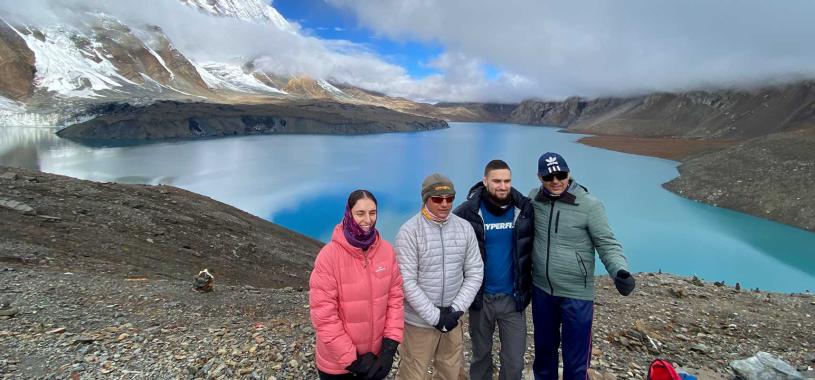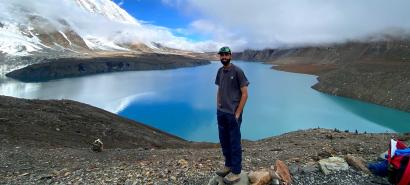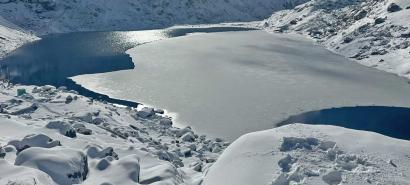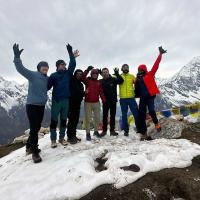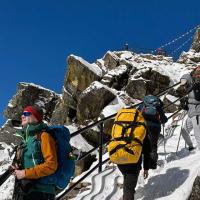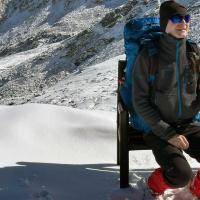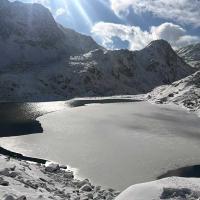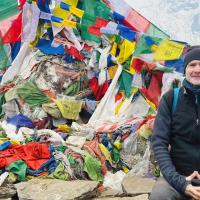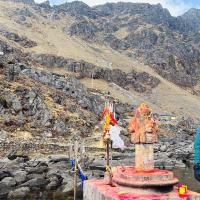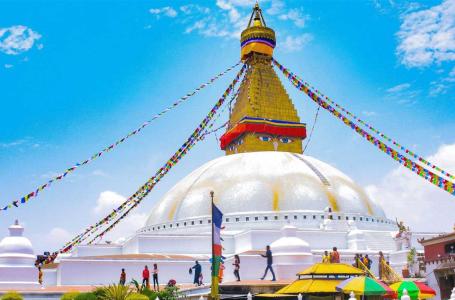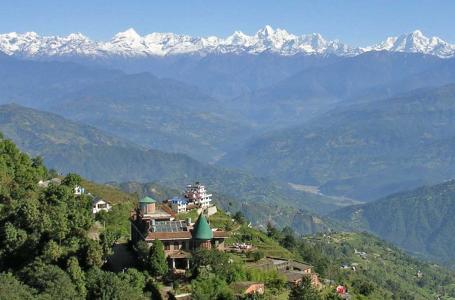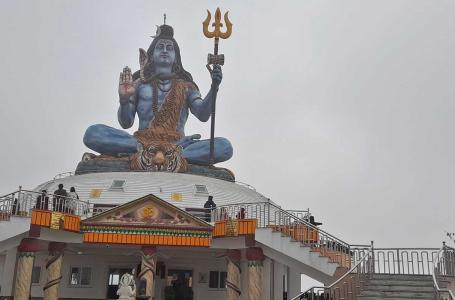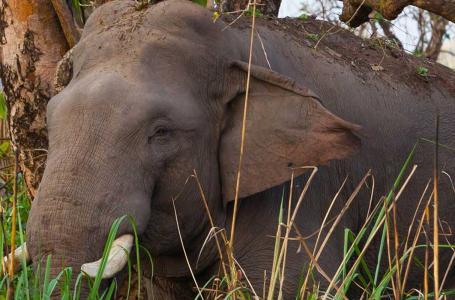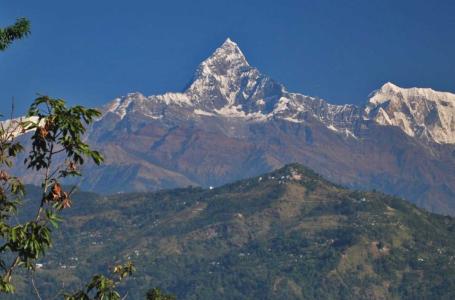- 01Pax USD 1085 pp
- 02 to 05Pax USD 850 pp
- 06 to 10Pax USD 750 pp
- 11 to 15Pax USD 700 pp
Itinerary
The adventure begins when you hit on the drive to Syabrubesi. Out of two route options (via Kakani or Galchi), the views from the path to Kakani are more thrilling and intoxicating. But, in terms of time, Kakani route takes nearly 9 hours to reach Syabrubesi while the road via Galchi takes 2 hours less. You may either catch a local bus or hire a jeep, but the recommended option would be a Jeep (although quite expensive). The bus conditions are unexpectedly filthy.
From Syabrubesi, the trail divides into two, both of them leading to the Lama Hotel. However, the upper route provides better views than its counterpart. For a while, the trail meanders around the local villages and then, climbs a steep bluff towards the Khangjim Gompa, a traditional monastery that still catches the eye of the trekkers with its aesthetic outlook.
From there, Sherpa Gaon is not far away, where hardworking Sherpas can be seen walking in their field. Afterward, the trail climbs a ridge, opening up the grand views of the Ganesh Himal, Lower valley and some parts of the Langtang village. When you arrive at Rimche, you will follow the Langtang Khola until making an appearance at Changdam, or popularly known as the Lama Hotel.
The trek to Langtang village is full of surprises. The Langtang Khola follows the trail throughout today’s journey. As you leave the Lama Hotel, the vegetations start to change into a semitropical type, with shrubs and meadows around.
It is after you cross Ghodatebela that will you encounter some of the deserted upland meadows, where the yaks eke out a tough living. The fleeting glimpses of the Langtang lirung keep on spicing up the trip. Then, a chain of Chortens and prayer wheel lead you to the Gumba village. From there, the welcoming Langtang village is not very far away.
Kyanjin Gompa is the highlight of the trek. It is large, classic, and epitomizes the ancient Tibetan Buddhist cultures and traditions. In fact, it is the largest monastery of the Langtang valley. Beautiful paintings of the Buddha and his disciples are displayed around the walls. This monastery is simply one of the most beautiful creations.
From the Gompa, hit on the side trip to Lirung Lake, one of the most serene and pristine lakes in Nepal. The incredible snowy cliffs, surrounding the lake, form a compelling scene. When you rise to one of these cliffs, the lake appears turquoise in color, and quite far away, there smile the glittering peaks of the Langtang range and Ganesh Himal. It is such inviting scenery. You will return to Kyanjin village after exploring the Lakeside.
Early in the morning, we will rise up to the Kyanjin Ri to witness the glorious sunrise over the spectacular mountain vistas of the Langtang region. It is indeed a nice walk, and you will get to see some of the incredible glaciers, prodigious mountains, and some never-before-seen landscapes. It is windy and cool at the top of the ridge, so you will return to the Kyanjin village for lunch. Then, you will retrace your steps back to the Langtang village for the night stay.
Return to the Lama Hotel along the same route through which you have passed earlier. The tracks are mostly descending, but they still have the charm to entice your soul.
The path until Rimche is same as the earlier route, but from there, we will proceed along the lower tracks until we meet up at a junction that shows the way to the Thulo Syabru. It is indeed a welcoming journey as you get to see some new landscape features and amazing local people. The trail zigzags several times around the hilly tracks, just to plunge you into some extraordinary meadows. When you reach Thulo Syabru, explore the Chortens and Mani walls and they reflect the beauties of ancient Buddhist civilization.
The trail to Chandanbari is indeed very much gratifying. You will pass through a wonderful forest, saturated by the wild birds and butterflies all around. The views of the Ganesh Himal and some parts of the Langtang range encourage you to explore more ahead. Within a short while from the forest, you will encounter a beautiful set of Chortens, with prayer flags wrapped around it.
This track guides you towards an easy-looking path to Kharka (pasture) overlooking the wonderful panorama of Ganesh Himal, Gatlang, and Trishuli Valley. Soon, you will come across another pasture that leads you to the village of Chandanbari, popularly known as the Shin Gompa. This monastery is small and not so aesthetically garnished, but it has the ability to entice the visitors with its time-honored history and culture. Talking with the Lamas is the best way to know about the monastery.
From the Chandanbari, follow the southern route to the Gosainkunda. Within a couple of minutes of leaving the village of Chandanbari, the grand vistas of the northern Himalayan range open up. The trails are exposed, and it wavers through several ups and downs over the wonderful ridge of the Langtang region. As you reach the Nagthali, the views grow even more sensational. The peaks of the Ganesh Himal, Himalchuli, and even the Annapurna form undeniable scenery.
As you reach the Laurebina, the snowy peaks begin to show off in a more elegant way. Within just an hour, you will come across the Saraswati Kunda, the first lake in the lakes of the Gosainkunda. Then, a line of Chortens lead you to the Bhairav Kunda and subsequently to the pristine lake of the Gosainkunda. You may dive into the water but beware of the hypothermia. After exploring the lakes, check-in to one of the lodges at the Gosainkunda village.
The path from Gosainkunda to the Phedi is not so taxing, as it appears. Cross the lakes of Dudh Kunda, Ganesh Kunda, and Surya Kunda before ascending to the incredible Laurebina Pass, overlooking the views of gorgeous peaks and glaciers. From the pass, descend along the pleasant track, lined up by the cairns of stones and some colorful Chortens. A beautiful meadow on top leads you to the village of Gyaje. Through the rough trail, fenced by the Juniper shrubs, you will head up to the Phedi, our next station. It is a wonderful place to stay.
From Phedi, Kutumsang is a long way, but the inviting glimpses of the fabulous landscapes and overhanging rocks create an undeniable setting. You will encounter the first waterfall of the journey before Ghopte. From there, the pleasant forest of the rhododendron will guide you toward the Mera Kharka, offering unparalleled views of the lower valleys and the meadows.
Then, head up to the Tharepati to witness amazing Chortens and Mani walls. From there, we will continue towards the Mangengoth through the quaint settlements and pastures. The views of the lower valleys and the moraines are simply amazing. Within 3 hours, you will arrive at the Kutumsang, a classic Tamang settlement.
As you progress down from the Kutumsang, the rocky hills turn into arable land. The houses change from two-tiered thatched roofs to one-tiered tin-roofed concretes. Within a few hours, you will make an appearance at the Thodung. From there, the trail to Chisapani is pretty tough to climb. But, the views of incredible Annapurna range, Ganesh Himal and the Jugal range compensate the pain of the climb. The glorious glaciers and the unparalleled icy buttresses follow your eyes for a long time until the forest leading to Chisapani block the views. The village of Chipling is indeed a welcoming place to stay. Soon, you will show up at Chisapani.
From Chisapani, the trail progresses through the Shivapuri National Park and heads towards the Sundarijal. It is a pleasant journey. Once you arrive at the Sundarijal, catch a drive back to your hotel at Kathmandu.
Overview
Langtang Gosaikunda and Chisapani Trek is an ideal package to explore the best sites of the Langtang Valley. From the incredible views of the Kyanjin Ri viewpoint to the unparalleled turquoise lake of the Gosaikunda, no part of this trek is disappointing. Each day you will meet up with new surprises. The main highlights of this trek are Kyanjin Gompa (the largest monastery of the Langtang valley), Kyanjin Gompa, Sherpa Gaon, Shin Gompa (monastery), Gosainkunda and its siblings, Mangengoth, Mul Kharka, and Chisapani. Besides, the brilliant landscapes and the undeniable peaks of the Langtang range, Ganesh Himal, and the Annapurna range are simply fabulous parts of this overall trekking.
This trek is also a cultural tour as you come across some of the classic settlements, where people are deeply inclined to their time-honored cultures and traditions. Chew a chat with the locals to know more about the brilliant history of this Himalayan kingdom.
This trek can be done in any season except the winter. Monsoon is not so good but trekking is possible. Spring and Autumn, however, are the best seasons. Plus, this trek can be attempted by anyone, who is at least fit to walk for long hours. To give it the age, we would say 12-60 years old, but even the 80s gentlemen can go for it if they are healthy and have a strong willingness to trek in the Langtang region. For sure, you will return with more energy and more inspiration from the trek.
To know about this package and further, please contact us.
Planning:
Planning a trek to Langtang Gosaikunda and Chisapani in Nepal is an exhilarating adventure that requires careful preparation. Plan your trekking itinerary carefully, typically including stops at Dhunche, Shin Gompa, Laurebina, Gosaikunda, and Chandanbari, adjusting it to your pace and preferences. Acclimatization is essential to avoid altitude sickness, so allocate at least one extra day at Gosaikunda or another high point to allow your body to adjust. Prioritize safety during your trek by carrying a fully charged mobile phone and informing someone of your trekking plans. Lastly, savor the journey by immersing yourself in the stunning Himalayan vistas, lush forests, and local culture along the way. Remember to be environmentally conscious, leaving no trace of your presence, and enjoy the natural beauty that the Gosaikunda Trek has to offer.
Similarly, appropriate gear is a must for crossing the incredible high passes of Langtang. A normal set of trekking gear is enough to cross these passes, however, in bad weather conditions, you might require some more advanced equipment.
The Best time to do the Langtang Gosaikunda and Chisapani Trek:
Autumn (September, October, and November) is the best time for the Langtang Gosaikunda and Chisapani Trek. The weather is clear and stable, offering stunning mountain views, pleasant daytime temperatures, and dry trails. This is the peak trekking season, so the trails are livelier with fellow trekkers.
Spring (March, April, and May) is another great time to trek. The weather is warm, and the rhododendron forests bloom beautifully, making the trek more scenic. Unlike high-altitude regions like the Everest Three Passes Trek, the risk of avalanches is low in this region.
Monsoon (June, July, and August) is not ideal due to heavy rainfall, leeches, and slippery trails. However, the landscapes are lush, and experienced trekkers who don't mind the rain can still attempt the trek.
Winter (December, January, and February) can be challenging at higher elevations like Gosaikunda (4,380m) due to freezing temperatures and heavy snowfall. However, if well-prepared, trekkers can enjoy peaceful trails and crystal-clear mountain views.
Food and Accommodations:
Throughout the Langtang Gosaikunda and Chisapani Trek, you'll find a network of teahouses and lodges in the villages along the trail. These provide accommodation and meals for trekkers. The quality and comfort of teahouses can vary, but most offer basic amenities such as beds with blankets, shared bathrooms (often squat toilets), and communal dining areas. Keep in mind that facilities may become more basic as you ascend to higher altitudes. Hot showers may not always be available, and heating can be limited at higher elevations.
You can also find a variety of food options but it is recommended to consult your guide for better and hygienic options.
Transportation:
There are many transportation options in order to reach Syabrubesi(which is the starting point of the Langtang trek). Fist one is a Local bus, Which can be easily accessible in Gangabu bus park. The journey typically takes around 7-9 hours, depending on road conditions, and offers scenic views along the way. And if you prefer a much more comfortable or faster option then you can also opt for a private vehicle. Once we reach Syabrubesi, our journey will finally begin on foot and we will trek through lush forests, villages, and scenic landscapes to reach Langtang and its surrounding areas.
Necessary Permits & TIMS:
To trek to Langtang, Gosaikunda, and Chisapani in Nepal, you will need to obtain the necessary permits, including the Langtang National Park permit and a TIMS (Trekkers' Information Management System) card. These permits are essential to ensure your safety, track trekkers in the region, and support local conservation efforts.
- The Langtang National Park permit is required for trekking in the Langtang region.
- The TIMS card is an additional permit required for trekking in Nepal. It is intended to help authorities keep track of trekkers for safety purposes.
- Depending on the specific route and villages you visit along the way, you may also need additional local permits. These are typically obtained at checkpoints during the trek. Your trekking agency or guide can assist with obtaining these permits if required.
Highlights
- Combined journey to the Langtang region that takes us to Langtang Valley and Gosaikund Lakes
- Explore diverse flora and fauna inside the Langtang National Park
- Explore the World Heritage sites of Kathmandu Valley
- Get the astonishing sceneries of Langtang Lirung, Yala Peak, Cherko Ri, Ganesh Mountain Range, Manaslu Mountain, and so on.
Cost Details
- Airport pickup and drop service
- Accommodation in Kathmandu (Hotel Chhimeki 2night).
- All food during the trek (B, L, D)
- Accommodation during the trek
- All Transportation costs: Comfortable Drive from Kathmandu to Trekking Starting Point and ending Point by Local Jeep, car, or bus. (depending upon the price and group size)
- Government license holder English-speaking guide.
- Guide salary, lodging, food and insurance
- Langtang National Park Permit and TIMS card
- First aid medical box
- T-shirt, Duffel Bag, and Trekking Map with company logo
- Rescue Management Service
- All Tax (13% VAT and 10% service charge)
- Farewell Dinner
- All kinds of Drinks
- Visa fee to enter Nepal
- International flight tickets
- Extra night accommodation and meal costs in Kathmandu due to any change in the scheduled itinerary.
- Porter (1 porter for 2 trekkers with a max load of 15 to 17kg).
- All required trekking gear like sleeping bags and down jackets made available on rent.
- Travel insurance/ Rescue operation costs
- All personal expenses
- Tip for guide and porters
Equipment List
- Woolen shirts and thick sweaters.
- Jackets (Fiber or down).
- Waterproof jacket with hood or poncho.
- Tracksuit, Track shoes and Trousers.
- Thermal Underwear and Thermal Coat.
- 2 pairs of loose-fitting long shorts/ skirts.
- Pair of Gloves and sandals.
- Woolen hat and long-sleeved shirt.
- Lightweight walking boots.
- 2 pairs of thin socks and 2 pair of woolen socks.
Snow glasses and sunglasses. - Trekking Sticks and Duffle bag or kit bag to carry to gear while trekking.
- Some (small/large) plastic bags to separate clean clothes from dirty ones and some smaller plastic bags to dispose garbage.
- Daypack bag to carry your personal requirements.
Water Bottle, water purifying tablets. - Towels, Umbrella (optional).
Headlamp, Binoculars, Camera, trekking map and compass, reading materials, pencil, rubber, pen, notebook, and moisturizer for lip, face body
FAQs
This trek passes through traditional Tamang and Sherpa villages, where you can explore Buddhist monasteries, observe local customs, and experience warm Himalayan hospitality. Gosaikunda Lake is also a sacred pilgrimage site for Hindus and Buddhists.
The trek offers teahouse accommodations, which are basic lodges providing meals and rooms with simple bedding. In higher altitudes like Gosaikunda, facilities may be more basic with shared bathrooms.
While it is possible to trek independently, hiring a licensed guide enhances safety and navigation, especially in remote areas. Porters can also help carry your load, making the trek more comfortable.
The trek begins in Syabrubesi, which is a 6-7 hour drive from Kathmandu. The trek ends in Sundarijal, from where you can take a short drive back to Kathmandu.
Yes, notable sites include Kyanjin Gompa in Langtang Valley, the sacred Gosaikunda Lake, and monasteries along the trail. Trekkers should respect local customs, especially during the Janai Purnima festival, when pilgrims visit Gosaikunda.
Travellers Review
Amazing trek to Langtang valley and Gosaikunda lake
I had an amazing time on my trek to Langtang valley and lake Gosaikund. My guide Pradip was experienced and friendly. He explained a lot about landscape and cultural sites along the way. And he took very nice pictures! The trek was very well organized by Devaraj from Trek mania. A great experience for me!


